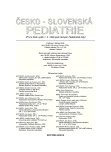Metabolic Parameters of Patients Attending Children Obesity (Obesitology) Outpatient Department
Authors:
Z. Marinov 1; J. Čepová 2
Authors‘ workplace:
Obezitologická ambulance, Dětská poliklinika, FN Motol a UK 2. LF, Praha
primář Dětské polikliniky MUDr. P. Tláskal, CSc.
1; Ústav klinické biochemie a patobiochemie UK 2. LF a FN Motol, Praha
přednosta prof. MUDr. R. Průša, CSc.
2
Published in:
Čes-slov Pediat 2010; 65 (2): 72-78.
Category:
Original Papers
Overview
A t the present time there are over 20,000 obese children in the European Union who suffer from diabetes mellitus type 2, 400,000 children with glucose tolerance disorders, over one million of obese children display signs of a cardiovascular disease including hypertension and increased cholesterol levels and display three or more signs of the metabolic syndrome.
The condition of our childhood obese population is under consideration. The authors analyzed metabolic parameters of 165 children attending Children Obesity Outpatient Department who suffered from polygenic obesity. In an equivalent cohort according to sex, age and body mass categories there were 42% of obese children with simple obesity, 20% obese children with hypercholesterolemia, and 38% of children with complex metabolic changes.
The results made it clear that situation in our child obese population is equally alarming as it is in other developed civilized countries. In the child obese population the incidence of complex metabolic changes has risen steeply with age, the degree of obesity and proved to be higher in the male sex. A new phenomenon is a three-fold higher incidence of complex metabolic changes in comparison with present criteria of the metabolic syndrome.
Key words:
children obesity, complex metabolic changes, metabolic syndrome
Sources
1. Fontaine KR, Redden DT, Wang C, Westfall AO, Allison DB. Years of life lost due to obesity. JAMA 2003 Jan 8; 289(2): 187–193.
2. Wadden TA, Stunkard AJ. Handbook of Obesity Treatment. New York: Guilford Press, 2002.
3. Calle EE, Rodriguez C, Walker-Thurmond K, Thun MJ. Overweight, obesity, and mortality from cancer in a prospectively studied cohort of U.S. adults. N. Engl. J. Med. 2003 Apr 24; 348(17): 1625–1638.
4. Kushner RF, Foster GD. Obesity and quality of life. Nutrition 2000 Oct; 16(10): 947–952.
5. Lobstein T, Jackson-Leach R. Estimated burden of paediatric obesity and co-morbidities in Europe. Part 2. Numbers of children with indicators of obesity-related disease. Int. J. Pediatr. Obes. 2006; 1(1): 33–41.
6. Reaven GM. Syndrome X: 6 years later. J. Intern. Med. 1994; Suppl. 736 : 13–22.
7. Reaven GM. Role of insulin resistence in human disease. Diabetes 1988; 37 : 1595–1607.
8. Zimmet P, Alberti KG, Kaufman F, Tajima N, Silink M, Arslanian S, Wong G, Bennett P, Shaw J, Caprio S; IDF Consensus Group. The metabolic syndrome in children and adolescents – an IDF consensus report. Pediatr. Diabetes 2007 Oct; 8(5): 299–306.
9. Reaven GM. The metabolic syndrome: is this diagnosis necessary? Am. J. Clin. Nutr. 2006; 83 : 1237–1247.
10. Wallace TM, Levy JC, Matthews DR. Use and abuse of HOMA modeling. Diabetes Care 2004 Jun; 27(6): 1487–1495.
11. HOMA index – kalkulátor; www.dtu.ox.ac.uk.
12. Goldemund K. Obezita a metabolický syndrom. Pediatrie pro praxi 2003; 1 : 9–13.
13. Marinov Z. Rizika dětské obezity. Čes.-slov. Pediat. 2009; 64(3): 141–146.
14. Pařízková J, Lisá L. Obezita v dětství a dospívání. 1. vyd. Praha: Galén, 2007.
Labels
Neonatology Paediatrics General practitioner for children and adolescentsArticle was published in
Czech-Slovak Pediatrics

2010 Issue 2
- What Effect Can Be Expected from Limosilactobacillus reuteri in Mucositis and Peri-Implantitis?
- The Importance of Limosilactobacillus reuteri in Administration to Diabetics with Gingivitis
Most read in this issue
- Acute Kidney Injury – Classification, Etiology, Diagnosis
- Disorders of Sex Development: Currently Recommended Classification and New Knowledge of Gonadal Maldevelopment
- Acute Pyelonephritis – A Questionnaire Study of Diagnostics and Treatment in the Czech Republic
- Occurrence of Metabolic Syndrome and Its Components in Obese Children
